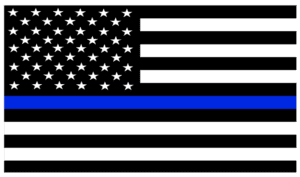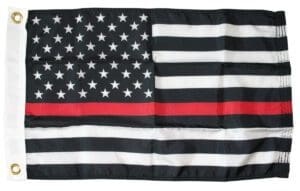Honoring the Serving and Fallen First Responders


The thin red, blue, and black lines in flags have various historical origins and meanings. Here's a brief overview:
- Thin Red Line: The thin red line refers to a British military term originating from the Battle of Balaclava during the Crimean War in 1854. As the story goes, a small British force bravely held their position against a large Russian cavalry, forming a defense line deemed "The Thin Red Line." This act of valor is associated with courage, resilience, and a willingness to stand firm in the face of adversity. Consequently, the thin red line is often used in flags and other symbols representing bravery, particularly in military and firefighting contexts.
- Thin Blue Line: The thin blue line commonly represents law enforcement agencies, policemen, and policewomen. Its history can be traced back to the United States, where it originated in support of the police community. The thin blue line symbolizes the role of law enforcement in separating order from chaos, maintaining peace, and upholding the rule of law. It signifies the dedication and sacrifice of those in law enforcement, protecting society against criminal activities.
- Thin Black Line: The thin black line is relatively newer and represents the mourning of fallen police officers. The black color symbolizes grief and mourning, paying homage to fellow officers who have lost their lives in the line of duty. It serves as a reminder of the sacrifices made by law enforcement officers while honoring their memories.
It's important to note that the symbolism and meanings of these lines may vary depending on the country, culture, or context in which they are used.
The Thin Blue Line flag is a symbol that serves as a tribute to law enforcement officers and represents the brotherhood and sacrifice of those who protect and serve their communities.
The origin of the Thin Blue Line flag dates back to the early 1950s when a blue light was first used to honor law enforcement officers who lost their lives in the line of duty. The idea behind this was to pay respect to fallen officers and to show support and solidarity for those who continue to protect and serve.
The design of the Thin Blue Line flag as we know it today was created by Andrew Jacob in 2014. The flag consists of a black and white American flag with a blue stripe running through the middle. The black and white colors represent the thin line between order and chaos, while the blue stripe represents law enforcement officers who keep that line intact.
The flag gained widespread attention and popularity after the murder of two New York City police officers, Rafael Ramos and Wenjian Liu, in December 2014. Following their deaths, a massive show of support for law enforcement flooded the nation, and the Thin Blue Line flag became a highly recognized symbol of solidarity.
Since then, the Thin Blue Line flag has been displayed on police cruisers, government buildings, and private residences to show support for law enforcement officers. It has also been used in protests and demonstrations advocating for police reform and for the recognition of the dangers faced by law enforcement officers.
However, the flag has also been a subject of controversy. Some argue that it has been misappropriated by extremist groups and has become a divisive symbol associated with criticism of the Black Lives Matter movement. Critics argue that it represents a militarization of police forces and a disregard for the need to address systemic issues within law enforcement.
Despite the controversy surrounding the Thin Blue Line flag, it continues to be a widely recognized symbol of support for law enforcement officers and a reminder of the sacrifices they make in the line of duty.